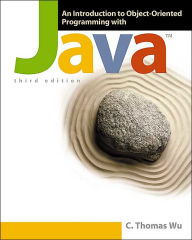
An Introduction to Object-Oriented Programming with Java Olc BI-Card / Edition 3
by C. Thomas Wu (Otani)ISBN-10: 0072921951
ISBN-13: 9780072921953
Pub. Date: 06/23/2003
Publisher: McGraw-Hill Companies, The
Overview
An Introduction to Object-Oriented Programming with Java provides an accessible and thorough introduction to the basics of programming in java. This much-anticipated revision continues its emphasis on object-oriented programming. Objects are used early so students begin thinking in an object-oriented way, then later Wu teaches students to define their own classes.
In the third edition, the author has eliminated the author-written classes, so students get accustomed to using the standard java libraries.
Also new is the use of smaller complete code examples to enhance student learning. The larger sample development programs are continued in this edition, giving students an opportunity to walk incrementally walk through program design, learning the fundamentals of software engineering. The number and variety of examples makes this a student-friendly text that teaches by showing.
Object diagrams continue to be an important element of Wu's approach. The consistent, visual approach assists students in understanding concepts.
Product Details
- ISBN-13:
- 9780072921953
- Publisher:
- McGraw-Hill Companies, The
- Publication date:
- 06/23/2003
- Edition description:
- Older Edition
- Pages:
- 800
- Product dimensions:
- 7.50(w) x 9.10(h) x 1.26(d)
- Age Range:
- 11 - 17 Years
Table of Contents
0 Introduction to Computers and Programming Languages 1 Introduction to Object-Oriented Programming and Software Development 2 Getting Started with Java 3 Numerical Data 4 Defining Your Own Classes 5 Selection Statements 6 Repetition Statements 7 Event-Driven Programming and Basic GUI Objects 8 Exceptions and Assertions 9 Characters and Strings 10 Arrays 11 Sorting and Searching 12 File Input and Output 13 Inheritance and Polymorphism 14 Advanced GUI 15 Recursive Algorithms Appendix A How to Run Java Programs Appendix B Sample Programs Appendix C Standard Classes and Interforces Appendix D UML DiagramsCustomer Reviews
Average Review: